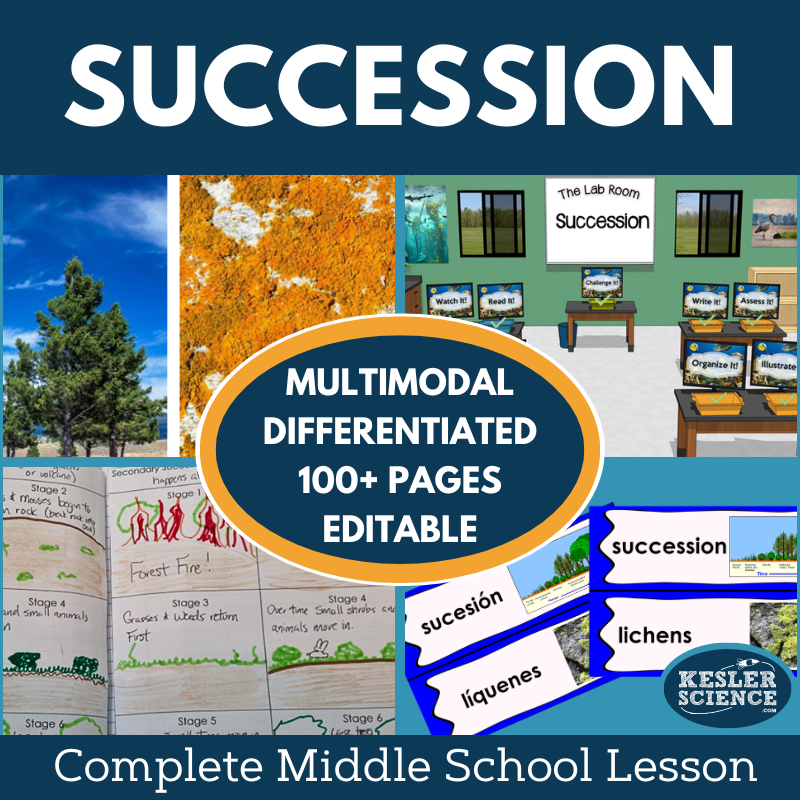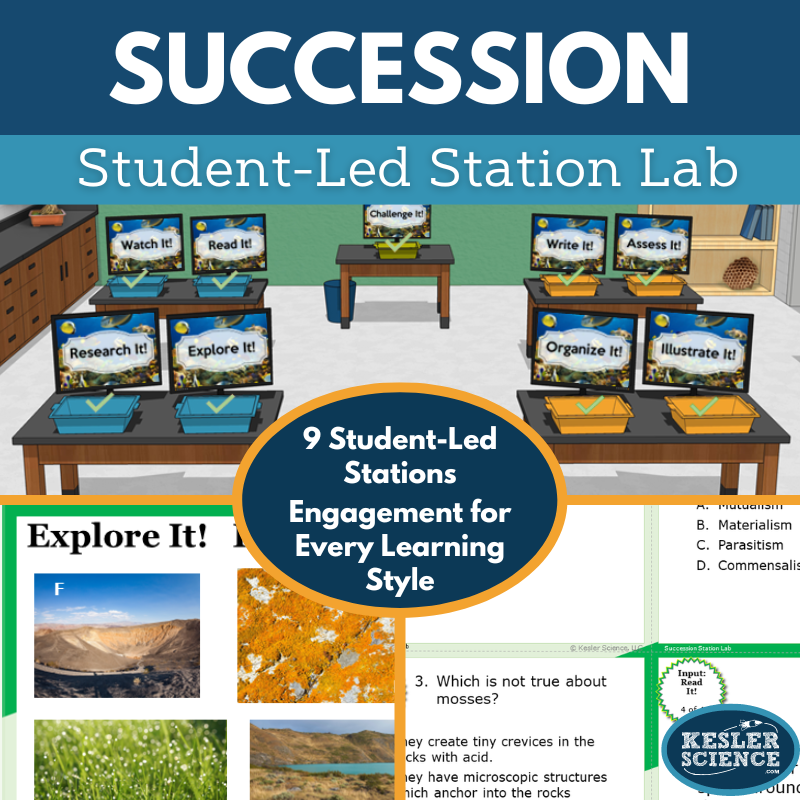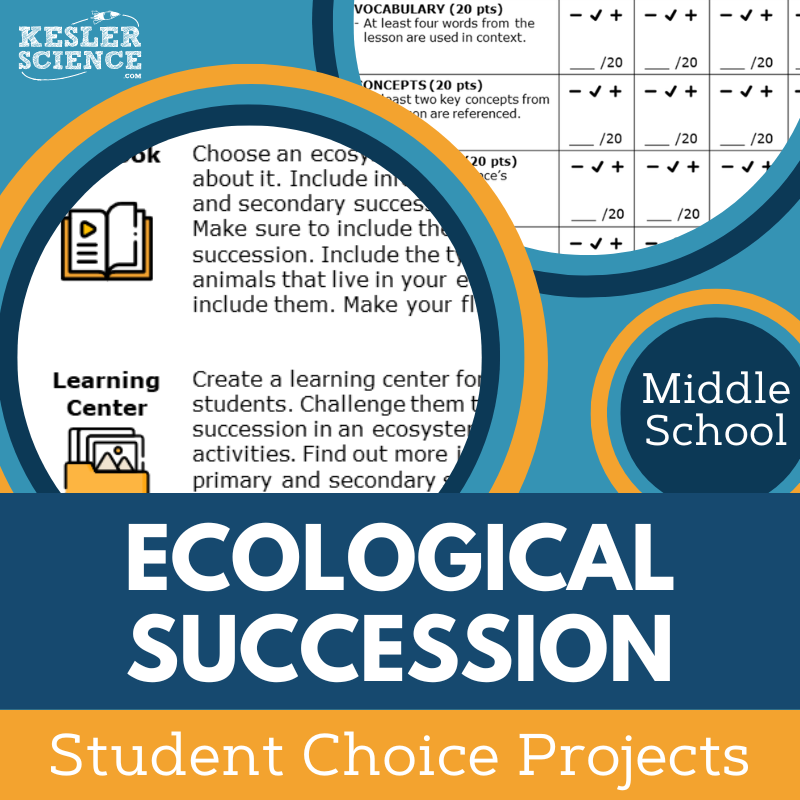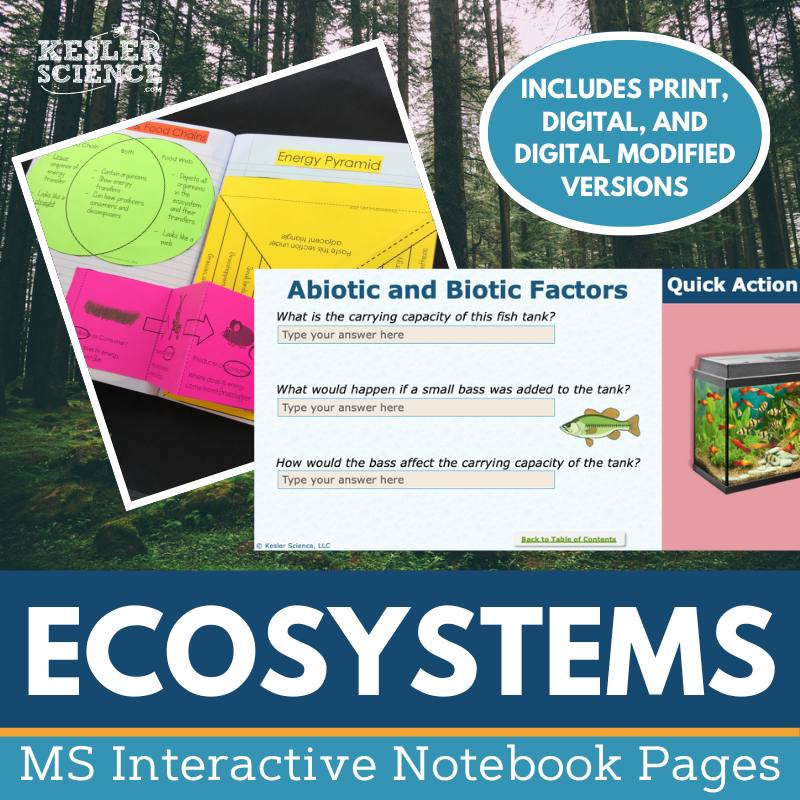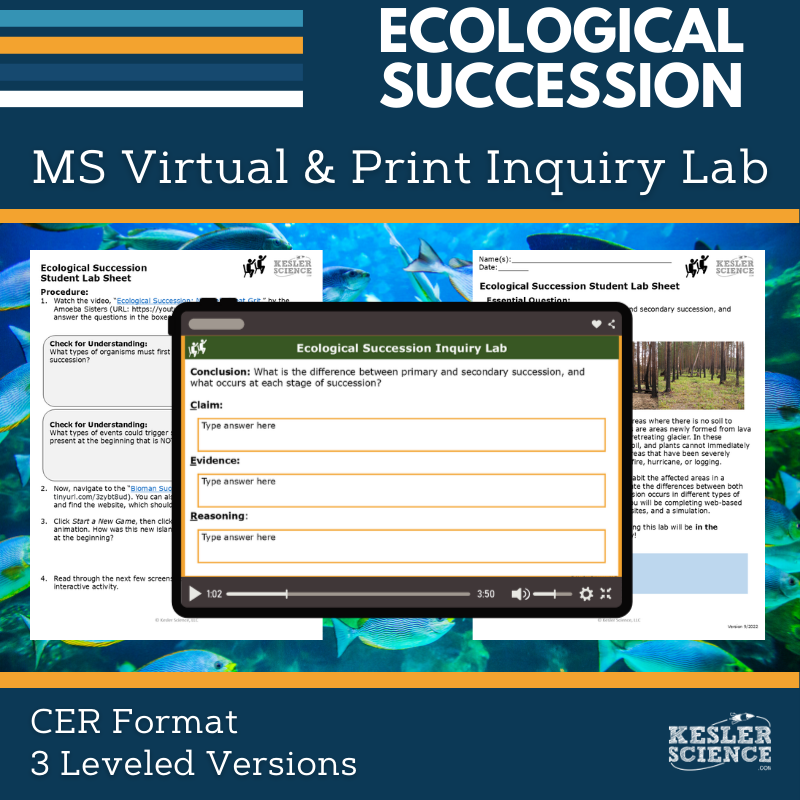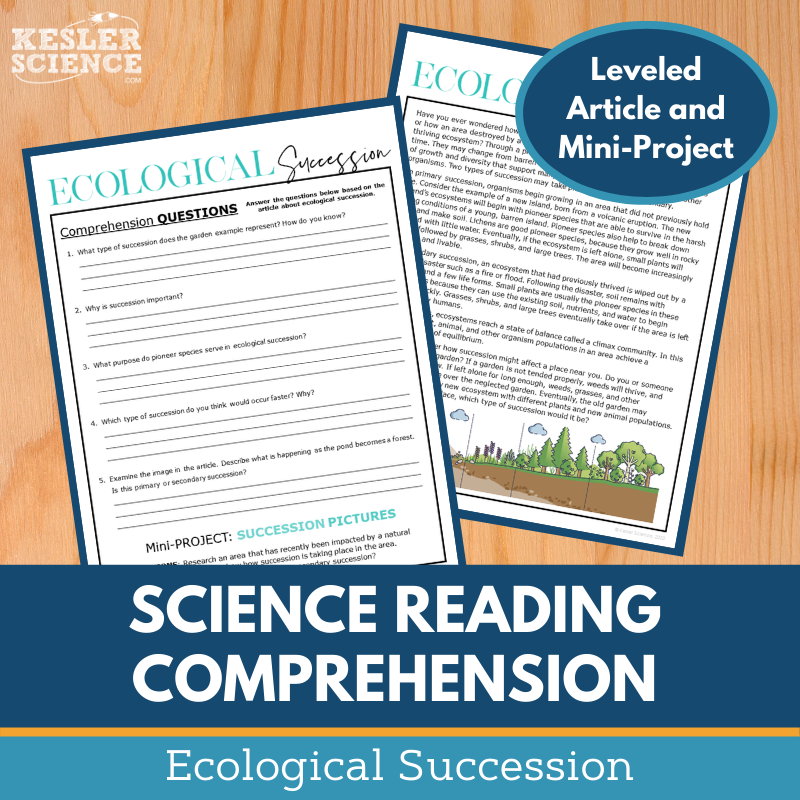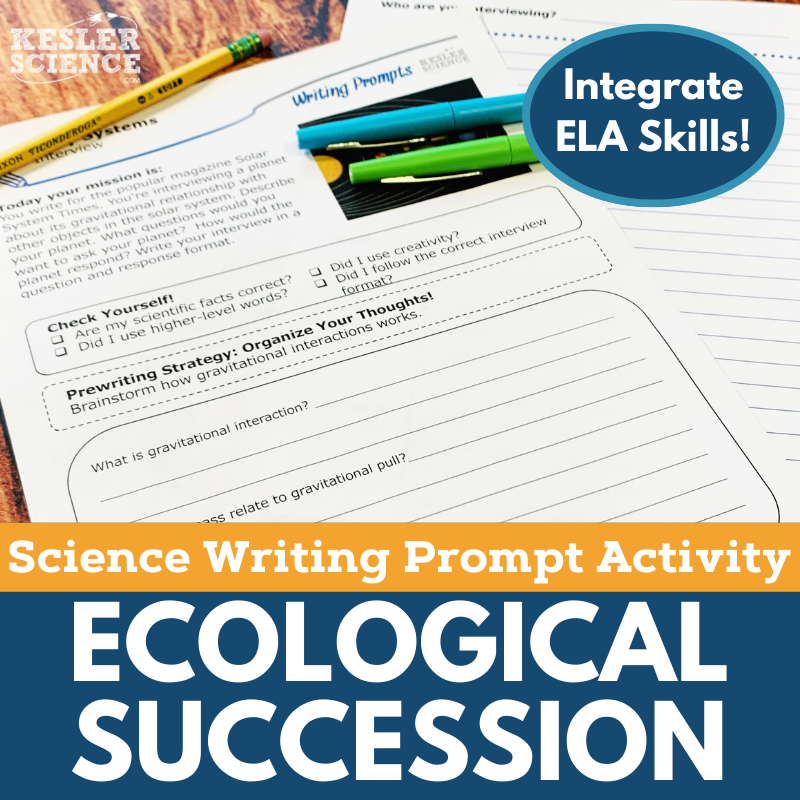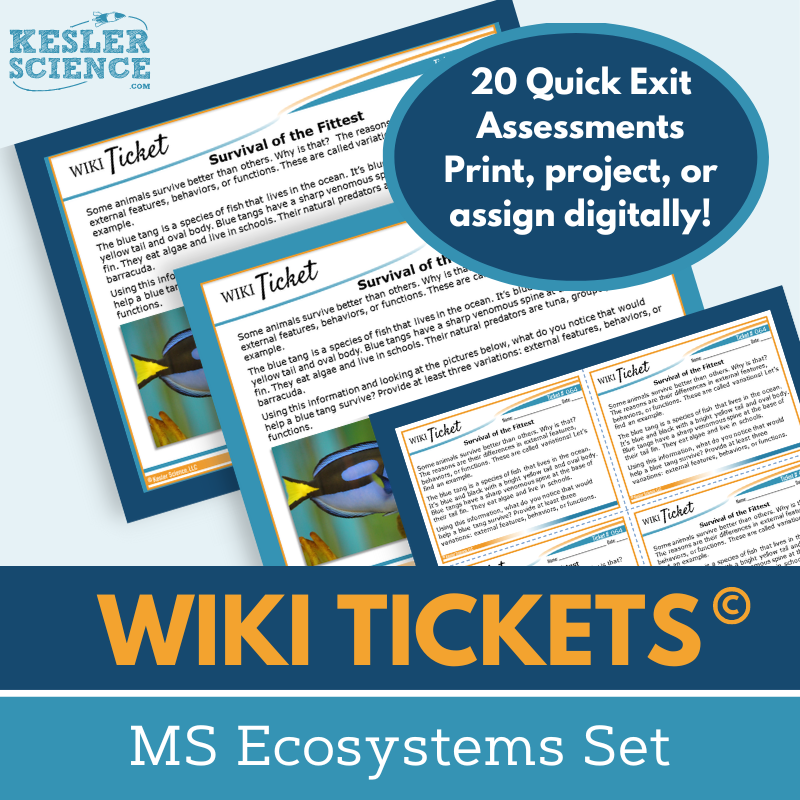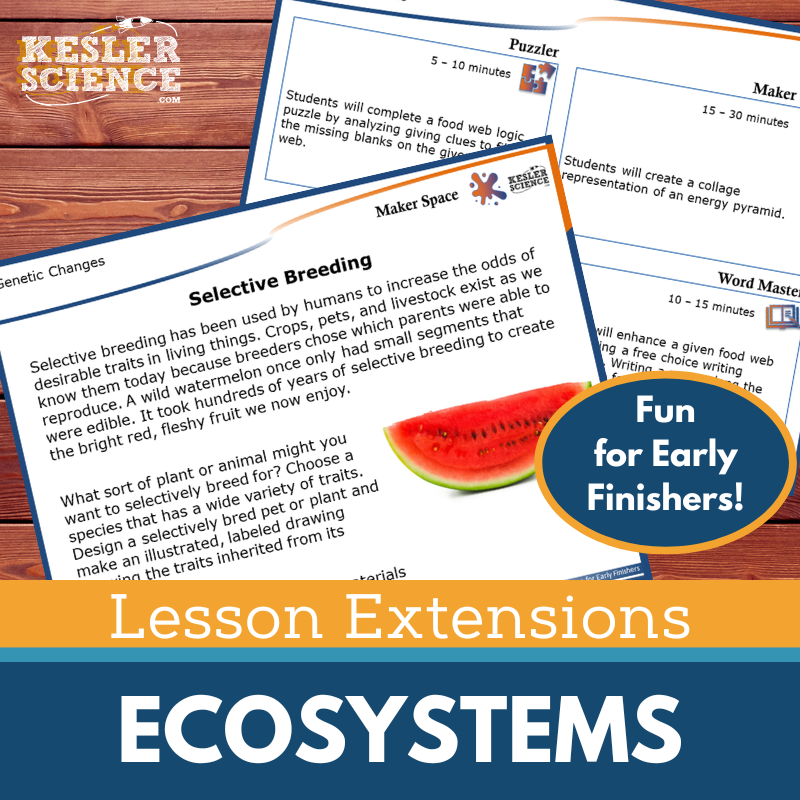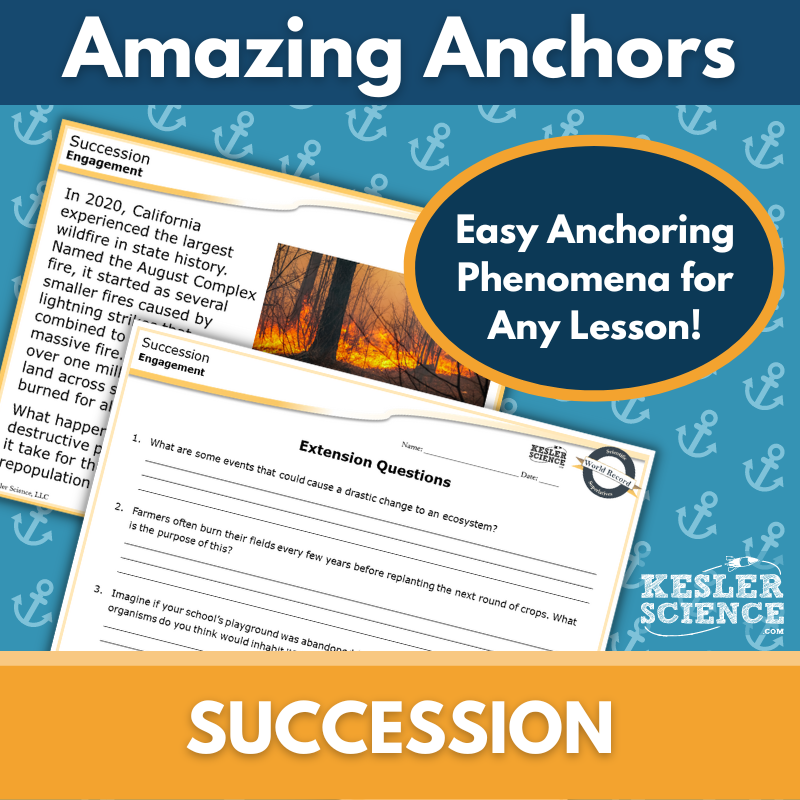Succession Activities for Middle School Science
The Kesler Science Succession resources offer a comprehensive, student-centered approach to teaching ecological succession in middle school. The resources below will give students a comprehensive understanding of succession. All of the following materials are also included in the Kesler Science Membership.
The Kesler Science Succession Complete 5E Lesson provides a fully structured, student-centered approach to teaching ecological succession. Designed for grades 6-8, this lesson requires minimal prep and guides students through an engaging, multi-day unit that fosters inquiry-based learning. The lesson helps students explore how ecological succession impacts habitats, with resources tailored to meet various learning needs, including differentiated materials and bilingual support.
The lesson follows the 5E model: Engagement, Exploration, Explanation, Elaboration, and Evaluation. In the Exploration phase, students engage with nine differentiated stations, offering multimodal learning opportunities like hands-on experiments, readings, research, and videos. Output stations allow students to showcase their learning through activities like organizing information, writing, illustrating, and demonstrating their knowledge of ecological succession.
In the Explanation phase, editable PowerPoints and interactive notebooks guide students through the content with ample opportunities for note-taking and engagement. The Elaboration phase extends the lesson with student-choice projects, while Evaluation includes assessments and review materials, all available in both printed and digital formats for in-person or virtual learning. This complete package ensures that all students can succeed while gaining a deep understanding of ecological succession.
The Kesler Science Succession Complete 5E Lesson provides a fully structured, student-centered approach to teaching ecological succession. Designed for grades 6-8, this lesson requires minimal prep and guides students through an engaging, multi-day unit that fosters inquiry-based learning. The lesson helps students explore how ecological succession impacts habitats, with resources tailored to meet various learning needs, including differentiated materials and bilingual support.
The lesson follows the 5E model: Engagement, Exploration, Explanation, Elaboration, and Evaluation. In the Exploration phase, students engage with nine differentiated stations, offering multimodal learning opportunities like hands-on experiments, readings, research, and videos. Output stations allow students to showcase their learning through activities like organizing information, writing, illustrating, and demonstrating their knowledge of ecological succession.
In the Explanation phase, editable PowerPoints and interactive notebooks guide students through the content with ample opportunities for note-taking and engagement. The Elaboration phase extends the lesson with student-choice projects, while Evaluation includes assessments and review materials, all available in both printed and digital formats for in-person or virtual learning. This complete package ensures that all students can succeed while gaining a deep understanding of ecological succession.
The Kesler Science Succession Station Lab provides a modular, student-led approach to learning about ecological succession. This hands-on activity allows middle school students to explore the concept of succession through eight differentiated stations. With minimal prep, students can work independently or in small groups, and the teacher facilitates rather than directs the learning.
The stations are divided into input and output activities. At input stations like "Explore It!" and "Research It!" students engage with multimodal content, including hands-on demos, readings, and online research. At output stations like "Illustrate It!" and "Write It!" students apply what they've learned through creative projects, written responses, and task cards that help demonstrate their understanding.
The station lab also includes a bonus "Challenge It!" station for advanced learners and early finishers, offering additional enrichment activities. Designed for both in-person and virtual learning, this resource comes with all the necessary signage, literature, and resources, ensuring that students can continue their learning seamlessly from any environment.
The Kesler Science Succession Station Lab provides a modular, student-led approach to learning about ecological succession. This hands-on activity allows middle school students to explore the concept of succession through eight differentiated stations. With minimal prep, students can work independently or in small groups, and the teacher facilitates rather than directs the learning.
The stations are divided into input and output activities. At input stations like "Explore It!" and "Research It!" students engage with multimodal content, including hands-on demos, readings, and online research. At output stations like "Illustrate It!" and "Write It!" students apply what they've learned through creative projects, written responses, and task cards that help demonstrate their understanding.
The station lab also includes a bonus "Challenge It!" station for advanced learners and early finishers, offering additional enrichment activities. Designed for both in-person and virtual learning, this resource comes with all the necessary signage, literature, and resources, ensuring that students can continue their learning seamlessly from any environment.
The Kesler Science Succession Student Choice Projects offer middle school students the opportunity to choose from six different project options or create their own. This flexible, student-led approach lets students express their understanding in a way that suits their output style. A grading rubric allows for assessments by teachers, peers, or the students themselves.
The project choice board includes nine options plus a "design your own" project, offering diverse ways for students to demonstrate their learning. Teachers can modify the rubric to suit specific grading needs, and the activities are differentiated to cater to a variety of learning levels. This allows for personalized, creative, and engaging work that meets individual needs.
Materials for the projects require minimal classroom supplies like paper, markers, and scissors, with many projects able to be completed digitally. The modified version of the project page offers support for students needing remediation, while more advanced students can tackle a combination of projects for added challenge.
The Kesler Science Succession Student Choice Projects offer middle school students the opportunity to choose from six different project options or create their own. This flexible, student-led approach lets students express their understanding in a way that suits their output style. A grading rubric allows for assessments by teachers, peers, or the students themselves.
The project choice board includes nine options plus a "design your own" project, offering diverse ways for students to demonstrate their learning. Teachers can modify the rubric to suit specific grading needs, and the activities are differentiated to cater to a variety of learning levels. This allows for personalized, creative, and engaging work that meets individual needs.
Materials for the projects require minimal classroom supplies like paper, markers, and scissors, with many projects able to be completed digitally. The modified version of the project page offers support for students needing remediation, while more advanced students can tackle a combination of projects for added challenge.
The Kesler Science Ecosystems Interactive Notebook Bundle provides an engaging and interactive way for students to explore key ecosystems concepts. Designed for flexibility, the resource includes both print and digital versions, making it suitable for traditional classrooms, 1:1 environments, and distance learning settings.
The bundle covers a wide range of topics, including biotic and abiotic factors, biomes, food webs, symbiosis, and the nitrogen and carbon cycles. Digital features include a unique interactive notebook PowerPoint, editable Google Slides compatibility, reflection pages, and modified versions for students with accommodations. The paper version includes blank and pre-filled templates, complete with color examples to guide students and teachers.
This resource supports differentiated instruction and accommodates all learners with thoughtfully designed templates and modifications. Whether in person or online, the Ecosystems Interactive Notebook promotes active learning, critical thinking, and scientific literacy.
The Kesler Science Ecosystems Interactive Notebook Bundle provides an engaging and interactive way for students to explore key ecosystems concepts. Designed for flexibility, the resource includes both print and digital versions, making it suitable for traditional classrooms, 1:1 environments, and distance learning settings.
The bundle covers a wide range of topics, including biotic and abiotic factors, biomes, food webs, symbiosis, and the nitrogen and carbon cycles. Digital features include a unique interactive notebook PowerPoint, editable Google Slides compatibility, reflection pages, and modified versions for students with accommodations. The paper version includes blank and pre-filled templates, complete with color examples to guide students and teachers.
This resource supports differentiated instruction and accommodates all learners with thoughtfully designed templates and modifications. Whether in person or online, the Ecosystems Interactive Notebook promotes active learning, critical thinking, and scientific literacy.
The Kesler Science Ecological Succession Inquiry Lab aligns with NGSS by helping students explore and differentiate between primary and secondary succession. Students will use interactive websites and videos to examine how ecosystems develop over time and how different types of organisms appear in sequence during the process of succession. Both the print and digital versions include comprehension questions, Claim-Evidence-Reasoning (C.E.R.) prompts, and a reflection section to deepen understanding.
The lab is offered at three levels—dependent, modified, and independent—to support learners with varying needs. The dependent version provides guided instructions and structured inquiry, the modified version includes simplified content and scaffolded questions, and the independent version encourages student-led investigation with minimal guidance. This flexible structure ensures all students can engage meaningfully with the content.
Teachers can choose between a hands-on printed lab or a fully interactive digital version that includes a pre-recorded video. All materials are editable and compatible with Google Slides. The lab includes teacher resource pages, answer keys, and options for multimodal learning to enhance engagement in middle school classrooms.
The Kesler Science Ecological Succession Inquiry Lab aligns with NGSS by helping students explore and differentiate between primary and secondary succession. Students will use interactive websites and videos to examine how ecosystems develop over time and how different types of organisms appear in sequence during the process of succession. Both the print and digital versions include comprehension questions, Claim-Evidence-Reasoning (C.E.R.) prompts, and a reflection section to deepen understanding.
The lab is offered at three levels—dependent, modified, and independent—to support learners with varying needs. The dependent version provides guided instructions and structured inquiry, the modified version includes simplified content and scaffolded questions, and the independent version encourages student-led investigation with minimal guidance. This flexible structure ensures all students can engage meaningfully with the content.
Teachers can choose between a hands-on printed lab or a fully interactive digital version that includes a pre-recorded video. All materials are editable and compatible with Google Slides. The lab includes teacher resource pages, answer keys, and options for multimodal learning to enhance engagement in middle school classrooms.
The Kesler Science Ecological Succession Reading Comprehension activity engages middle school students with a nonfiction article about how areas rebound after disturbances. Students will read, answer comprehension questions, and research an example of ecological succession, increasing both their reading comprehension and science literacy. This leveled passage, appropriate for grades 6-8, is available at Lexile levels 1100-1300, offering two different article versions for varying reading abilities.
Included in this resource are comprehension questions, a hands-on mini-project, and a Cornell notes template to help students organize their thoughts. Colorful graphics are provided, which can be easily printed in grayscale for classroom use. The resource is adaptable for both in-person and remote learning environments, making it suitable for platforms like Google Classroom, MS Teams, Schoology, or Canvas.
This reading comprehension activity is versatile, useful for a variety of classroom needs such as extra credit, science sub plans, and make-up work. Teachers can use the passages to build science literacy, provide opportunities for classroom discussions, and enhance students' textual analysis and comprehension skills.
The Kesler Science Ecological Succession Reading Comprehension activity engages middle school students with a nonfiction article about how areas rebound after disturbances. Students will read, answer comprehension questions, and research an example of ecological succession, increasing both their reading comprehension and science literacy. This leveled passage, appropriate for grades 6-8, is available at Lexile levels 1100-1300, offering two different article versions for varying reading abilities.
Included in this resource are comprehension questions, a hands-on mini-project, and a Cornell notes template to help students organize their thoughts. Colorful graphics are provided, which can be easily printed in grayscale for classroom use. The resource is adaptable for both in-person and remote learning environments, making it suitable for platforms like Google Classroom, MS Teams, Schoology, or Canvas.
This reading comprehension activity is versatile, useful for a variety of classroom needs such as extra credit, science sub plans, and make-up work. Teachers can use the passages to build science literacy, provide opportunities for classroom discussions, and enhance students' textual analysis and comprehension skills.
The Kesler Science Ecological Succession Science Writing Prompt Activity allows middle school students to explore life science concepts through creative storytelling. Using a storyboard format, students will demonstrate their understanding of ecological succession, engaging in both reasoning and writing. This resource enhances science literacy, making it ideal for elaboration or review activities.
Included in the product are teacher directions, answer guides, and editable rubrics, providing flexibility for assessment. Teachers can project the writing prompt or assign it digitally via PowerPoint or Google Slides, making it adaptable for both in-person and remote learning environments. Full-sized and half-sheet handouts are available for students to use in various formats, including interactive notebooks.
This resource is versatile, serving as a cross-curricular activity, pre-test formative assessment, or student choice project. It’s also great for extra credit, make-up work, or differentiation exercises, allowing teachers to tailor the prompt to meet diverse learning needs and classroom settings.
The Kesler Science Ecological Succession Science Writing Prompt Activity allows middle school students to explore life science concepts through creative storytelling. Using a storyboard format, students will demonstrate their understanding of ecological succession, engaging in both reasoning and writing. This resource enhances science literacy, making it ideal for elaboration or review activities.
Included in the product are teacher directions, answer guides, and editable rubrics, providing flexibility for assessment. Teachers can project the writing prompt or assign it digitally via PowerPoint or Google Slides, making it adaptable for both in-person and remote learning environments. Full-sized and half-sheet handouts are available for students to use in various formats, including interactive notebooks.
This resource is versatile, serving as a cross-curricular activity, pre-test formative assessment, or student choice project. It’s also great for extra credit, make-up work, or differentiation exercises, allowing teachers to tailor the prompt to meet diverse learning needs and classroom settings.
The Kesler Science Ecosystems WIKI Tickets are versatile formative assessments designed for 6th-8th grade science topics. These engaging assessments come in five formats for each topic: full screen for projection, three handout sizes (full, split, and quarter-page), and a digital interactive version that can be used as an editable PPT or Google Slides file. Perfect for checking understanding, these WIKI Tickets provide flexible options for in-person and virtual learning environments.
Aligned with NGSS and TEKS standards, each WIKI Tickets set includes a variety of topics like biodiversity, ecosystems, photosynthesis, and human impact. A bonus table of contents helps teachers quickly find the alignment for each standard. Some topics even have multiple tickets to reinforce key concepts and support student learning.
These assessments are ideal for use as exit tickets, bellringers, or anytime you need quick feedback on student progress. With digital and print formats available, they can be easily adapted for any classroom setting, providing a fun and effective way to gauge students' understanding of science concepts.
The Kesler Science Ecosystems WIKI Tickets are versatile formative assessments designed for 6th-8th grade science topics. These engaging assessments come in five formats for each topic: full screen for projection, three handout sizes (full, split, and quarter-page), and a digital interactive version that can be used as an editable PPT or Google Slides file. Perfect for checking understanding, these WIKI Tickets provide flexible options for in-person and virtual learning environments.
Aligned with NGSS and TEKS standards, each WIKI Tickets set includes a variety of topics like biodiversity, ecosystems, photosynthesis, and human impact. A bonus table of contents helps teachers quickly find the alignment for each standard. Some topics even have multiple tickets to reinforce key concepts and support student learning.
These assessments are ideal for use as exit tickets, bellringers, or anytime you need quick feedback on student progress. With digital and print formats available, they can be easily adapted for any classroom setting, providing a fun and effective way to gauge students' understanding of science concepts.
The Kesler Science Ecosystems Lesson Extensions offer student-choice activities to challenge fast finishers and encourage critical thinking. These activities provide engaging ways to deepen learning and can be used to wrap up lessons, prevent distractions, or fill gaps during testing. Each extension is designed to scaffold learning with activities that align with NGSS and TEKS standards, making them perfect for students ready to explore topics like ecosystems in more depth.
Included in each Lesson Extension are four activity types: Puzzler, Maker Space, Tech Connection, and Word Master. These activities focus on problem-solving, STEAM connections, digital media, and creative writing, providing opportunities for students to apply their knowledge in diverse and engaging ways. Both digital and paper versions are available, with teacher directions and answer keys for easy implementation.
These extensions are ideal for pushing independent learners further, offering rigorous, fun, and hands-on learning opportunities. With topics ranging from biodiversity to ecosystems and environmental changes, these resources help extend students' understanding of science concepts while reinforcing critical skills.
The Kesler Science Ecosystems Lesson Extensions offer student-choice activities to challenge fast finishers and encourage critical thinking. These activities provide engaging ways to deepen learning and can be used to wrap up lessons, prevent distractions, or fill gaps during testing. Each extension is designed to scaffold learning with activities that align with NGSS and TEKS standards, making them perfect for students ready to explore topics like ecosystems in more depth.
Included in each Lesson Extension are four activity types: Puzzler, Maker Space, Tech Connection, and Word Master. These activities focus on problem-solving, STEAM connections, digital media, and creative writing, providing opportunities for students to apply their knowledge in diverse and engaging ways. Both digital and paper versions are available, with teacher directions and answer keys for easy implementation.
These extensions are ideal for pushing independent learners further, offering rigorous, fun, and hands-on learning opportunities. With topics ranging from biodiversity to ecosystems and environmental changes, these resources help extend students' understanding of science concepts while reinforcing critical skills.
This Amazing Anchors Phenomenon Lesson introduces and reinforces the concept of ecological succession through a real-world example of a California wildfire. The two-part resource begins with an introductory reading that sets the stage using the wildfire scenario, accompanied by comprehension and extension questions to activate student thinking. An explanatory reading follows, clearly outlining the science behind ecological succession, with additional questions to deepen student understanding.
The resource includes teacher directions with answer keys, editable slides for projection, and both print and digital handouts in full- and half-sheet formats. These materials are aligned with TEKS standards and are suitable for use in both physical classrooms and virtual settings. A differentiated version supports diverse learners with simplified language and sentence starters.
Designed to bookend any lesson, this no-prep activity works especially well during the Engagement and Elaborate phases of the 5E model. Whether used as an introduction or follow-up, the readings and questions help students connect science content to real-world phenomena.
This Amazing Anchors Phenomenon Lesson introduces and reinforces the concept of ecological succession through a real-world example of a California wildfire. The two-part resource begins with an introductory reading that sets the stage using the wildfire scenario, accompanied by comprehension and extension questions to activate student thinking. An explanatory reading follows, clearly outlining the science behind ecological succession, with additional questions to deepen student understanding.
The resource includes teacher directions with answer keys, editable slides for projection, and both print and digital handouts in full- and half-sheet formats. These materials are aligned with TEKS standards and are suitable for use in both physical classrooms and virtual settings. A differentiated version supports diverse learners with simplified language and sentence starters.
Designed to bookend any lesson, this no-prep activity works especially well during the Engagement and Elaborate phases of the 5E model. Whether used as an introduction or follow-up, the readings and questions help students connect science content to real-world phenomena.
Year-Round Resources
These year-round activities will increase your students' understanding of many middle school science topics. All of these activities are also included in the Kesler Science Membership.
Visual Data & Graphing
You're not alone if your students struggle with understanding graphs, charts, and tables. It's a skill that takes an enormous amount of practice. This resource will help students build a strong foundation in analyzing data and creating their own data visualizations.
Bell Ringers and Warm-Ups
These middle school science bell ringers are an excellent way to engage your students as soon as they walk into your classroom. This comprehensive FULL YEAR resource includes everything you need to start off each science class with an interesting warm-up activity.
Review Board Games
Each game board has been carefully designed to keep students engaged. There are 10 different action spaces on each board and dozens of question cards. All of the actions are related to science concepts and keep the students motivated throughout the game.
Each game is ready to play. Simply print out the board and the cards and let the students enjoy reviewing nine different units.
Essential Questions
Below are the essential questions associated with the lessons and activities included in this unit. This topic is only one of more than 100 middle school science topics included in the Kesler Science Membership.
-
How can you observe, record, and describe the role of ecological succession in a habitat?
Kesler Science Membership
Imagine never having to search for another middle school science lesson again. The membership gives you access to ALL of the Kesler Science products in one place (Yes, including everything above).
Say goodbye to long hours of lesson prep.

